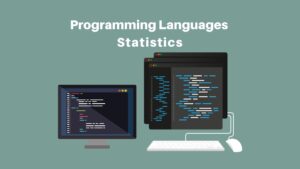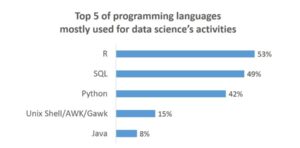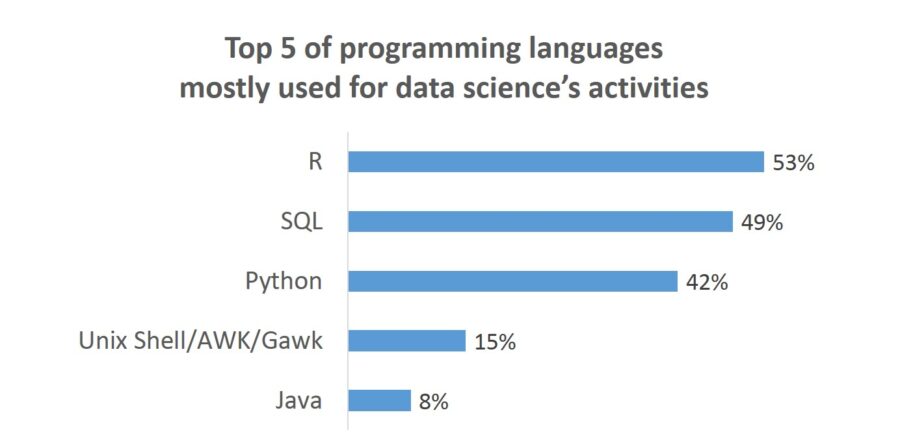
In the realm of statistical analysis, the choice of programming language is crucial for efficient data manipulation, analysis, and visualization. Back in 2004, several programming languages were at the forefront of statistical computing, each offering unique features and capabilities that catered to different aspects of data analysis. This article explores the top programming languages for statistical analysis in 2004, highlighting their strengths and typical use cases.
1. R
Overview
R, an open-source language and environment for statistical computing and graphics, was among the top choices for statisticians in 2004. Developed initially by Ross Ihaka and Robert Gentleman in 1993, R gained widespread popularity due to its comprehensive statistical capabilities and strong graphical features.
Strengths
- Extensive Packages: R’s CRAN (Comprehensive R Archive Network) repository offered numerous packages for various statistical methods, making it highly versatile.
- Powerful Graphics: R’s graphical capabilities were unmatched, allowing for the creation of detailed and customizable plots and charts.
- Active Community: A robust and active community provided extensive support, documentation, and continuous development of new packages.
Use Cases
- Academic research
- Biostatistics
- Social science data analysis
- Financial modeling
2. SAS (Statistical Analysis System)
Overview
SAS was a leader in statistical software in 2004, widely used in the industry for data management, advanced analytics, and business intelligence. It provided a comprehensive suite of tools for data analysis and reporting.
Strengths
- Enterprise Solutions: SAS was favored by large corporations for its robust data handling capabilities and enterprise-level solutions.
- Comprehensive Functionality: It offered a wide range of statistical and data analysis functions, from simple descriptive statistics to complex predictive modeling.
- High Performance: SAS was known for its efficiency in handling large datasets and performing complex calculations quickly.
Use Cases
- Pharmaceutical research
- Banking and finance
- Healthcare analytics
- Market research
3. SPSS (Statistical Package for the Social Sciences)
Overview
SPSS, developed by IBM, was another top language for statistical analysis in 2004, especially popular among social scientists. It provided a user-friendly interface along with powerful statistical analysis tools.
Strengths
- Ease of Use: SPSS’s graphical user interface made it accessible to users with limited programming knowledge.
- Comprehensive Analysis Tools: It offered a wide range of statistical tests and procedures tailored to social science research.
- Data Management: SPSS excelled in data management and manipulation, allowing users to clean and prepare data effectively.
Use Cases
- Survey data analysis
- Educational research
- Psychology experiments
- Marketing data analysis
4. MATLAB
Overview
MATLAB, a high-level language and interactive environment for numerical computation, visualization, and programming, was popular among engineers and scientists in 2004. It was widely used for matrix manipulations, algorithm development, and data visualization.
Strengths
- Numerical Computation: MATLAB was exceptionally powerful for numerical analysis and matrix computations.
- Toolboxes: A wide range of toolboxes extended MATLAB’s capabilities into various domains, including statistics, signal processing, and image processing.
- Visualization: MATLAB provided high-quality visualizations and interactive plots, aiding in data interpretation and presentation.
Use Cases
- Engineering analysis
- Scientific research
- Financial modeling
- Image and signal processing
5. S-PLUS
Overview
S-PLUS, a commercial implementation of the S programming language, was another prominent tool for statistical analysis in 2004. It was designed to handle large datasets and provided an environment for sophisticated data analysis and visualization.
Strengths
- Advanced Statistical Methods: S-PLUS supported a variety of advanced statistical techniques and models.
- Graphical Capabilities: Like R, S-PLUS was known for its strong graphical capabilities, enabling detailed and informative visualizations.
- Integration: It easily integrated with other software and data sources, making it versatile for various applications.
Use Cases
- Data mining
- Financial analytics
- Environmental statistics
- Pharmaceutical research
6. Stata
Overview
Stata was a powerful statistical software package used extensively in the fields of economics, sociology, and political science. It provided a comprehensive suite of statistical tools and an intuitive command syntax.
Strengths
- User-Friendly Interface: Stata’s intuitive command language made it easy to learn and use.
- Data Management: Stata excelled in data management and offered efficient data manipulation capabilities.
- Extensive Documentation: Comprehensive documentation and user support facilitated learning and application of Stata.
Use Cases
- Econometric analysis
- Epidemiology
- Social science research
- Policy analysis
Conclusion
In 2004, the landscape of statistical analysis was enriched by a variety of programming languages, each bringing unique strengths to the table. R and S-PLUS were favored for their advanced statistical and graphical capabilities, SAS and SPSS for their comprehensive enterprise solutions, MATLAB for its numerical computation prowess, and Stata for its user-friendly interface and robust data management. The choice of language depended largely on the specific needs of the analysis, the background of the user, and the industry requirements. These languages laid the foundation for the modern tools we use today, continuing to influence the development of statistical computing.



